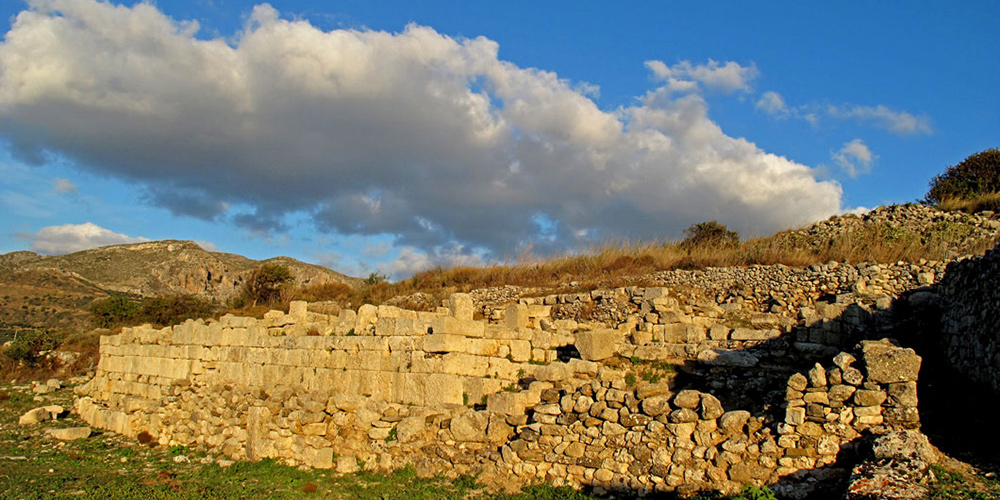Ancient Praisos was a major city of the Eteocretans (= “true” or “original” Cretans, the descendants of the Minoans), and one of the most important urban centres of Eastern Crete. It was located in the area between Kalamafki and Pandelis, the two branches of the present-day river Stomio (ancient Didymos).Praisos was built on three hills and was surrounded by strong walls. Remnants of these walls can be seen today at various places, including the north-east area on the tallest of these three acropolises, where the headquarters of the city authorities were to be found. On the lowest of them, outside the city walls, there were an altar-sanctuary and a sacred cave (at the location of Skoles). The area was probably occupied since the Neolithic age. Neolithic pottery and Minoan Kamares Ware vessels werefound in the cave at Skoles, where the rivers Kalamafki and Pandelis meet.

After Crete was taken by the Dorians, in the 12th century BC, the Eteocretans, who were believed to be the original Cretans, retreated to the eastern part of the island, where they preserved their genuine Minoan character, their language, their religion and the worship of Dictaean Zeus (Diktaios Zeus).
Praisos is situated at about the middle of the Sitia peninsula and had two ports: Itia (current Sitia) on the northern shore (Cretan Sea), and Stiles on the southern shore (Libyan Sea). Stiles was mentioned as a port of Praisos in a decree of the Praisians, dating to the Macedonian years, about fishery, the trade of Murex shells yielding purple-dye, and the hiring of the fleet of Stiles for trading purposes. The territory of Praisos occupied the whole of the peninsula of Sitia (which was called then Eteocretan peninsula or peninsula of the Praisians), excluding the area of Itanos. The people of Hierapytna, who were of Doric origin, eventually won the long war with the Eteocretans of Praisos, and destroyed their city.
The first Eteocretan inscription to be discoveredand a large number of clay figurines were unearthed at Praisos byFederico Halbherr, in 1884. Excavations conducted by the British School of Archaeology proved that Praisos was actually a city of the historical(Hellenic)years. The previous phase of Praisos, the town of the Eteocratans, which was mentioned by Strabo, existed not far from the ruins that can be seen today; the last descendants of the Eteocretans and Dorian settlers built the new city, after the 12th century BC, when old Praisos was destroyed.
Praisos of the Geometric years had a democratic political system and was governed by the kosmoi (= rulers of the Doric city-states in Crete), the Senate and the Ecclesia (= a political body, consisting of all male citizens). Being an autonomous city, it minted its own currency; many of its coins have been identified today, and most of them bear representations of Heracles, Zeus, Apollo andDemeter, as well as the inscription ΠΡΑΙΣΙΟΝ(PRAISION).
A tomb of a Praisian athlete, who was buried together with his prizes, was uncovered in 1935 on top of one of the acropolises of Praisos; the most noteworthy of these artefacts are two decorated Athenian amphorae dating from 560-500 BC. It seems that the athlete had taken part in the Panathenaic games, and he came back a victor.
All phases of Hellenic history have left their mark on Praisos; from the Neolithic age, the Mycenaean era, the Geometric and the Hellenistic years, to the Venetian period. In the nearby village of Vaveli, two Turkish fountains can also be seen today.




